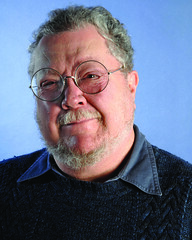
PREV ARTICLE
NEXT ARTICLE
FULL ISSUE
PREV FULL ISSUE
INTERVIEW WITH SMITHSONIAN NUMISMATIC CURATOR RICHARD DOTY
Dick Johnson was the first to notice this nice article from The Collectors Weekly, interviewing Dick Doty, curator of the National Numismatic Collection at the Smithsonian. The article is illustrated with images of Private & Pioneer Gold Coins from the collection, and notes that Doty has a new book in the works. Here are some excerpts.
-Editor
When I was growing up in Oregon in the 1950s, early ’60s, we were still using silver dollars. When you’ve got something like that in your hand, you know it’s money—it has heft, it has weight. It’s funny: I wrote an entire book on obsolete bank notes, but I never actually collected them. I think I’m probably more of a world collector than a U.S. collector. I have some U.S. coins, and I used to like U.S. large cents when I was younger, but I’ve been collecting ancients and world stuff more than anything else. In my job here at the Smithsonian, I have to know a little about everything, basically. I’m curator of everything, from ancient Greek to modern U.S. I wrote this book on obsolete currency called "Pictures From a Distant Country." The book, which is being published this year by Whitman, focuses on the images on 19th-century obsolete currency, the stuff that we used until the Civil War got us into Federal currency. These images tell us a lot about how the people of the time thought about everything from the role of women to African Americans, who were still slaves. The notes also reveal how the country viewed Native Americans, which industries were most important, and what progress and national identity meant. If you want to see what a locomotive in 1855 looked like, there are daguerreotypes for that, but if you want to see what it meant to the nation, take a look at a note with a train on it, spewing fire and steam and chugging its way into the future. I was only able to write that book because the collection of obsolete currency here at the Smithsonian is superb. It’s the best one I’ve ever seen. Before I came to Smithsonian I had been at the American Numismatic Society in New York. Toward the tail end of my time at the ANS, probably from beginning of the 1980s, I got into numismatic technology—how the actual coins and notes were made. That’s been a pretty consistent interest of mine ever since. Two areas that I collect now are errors and oddball things. Mints are secretive affairs, and paper printers are even more secretive. They don’t like you looking at the machinery that produces the coins or currency because you might get inspired to go home do it yourself. So, if you are interested in technology in terms of how this stuff was made, the coins or notes are your best witnesses, and the ones that didn’t come out quite right are the best witnesses of all.
To read the complete article, see:
An Interview with Smithsonian Coin and Currency Curator Richard Doty
(www.collectorsweekly.com/articles/an-interview- The Numismatic Bibliomania Society is a non-profit organization promoting numismatic literature. See our web site at coinbooks.org. To submit items for publication in The E-Sylum, write to the Editor at this address: whomren@gmail.com To subscribe go to: https://my.binhost.com/lists/listinfo/esylum All Rights Reserved. NBS Home Page Contact the NBS webmaster 
|
